
The American dictionary, Merriam Webster recently tweeted, ‘Lookups for ‘feminism’ spiked today. It’s “the belief that men & women should have equal rights and opportunities.” It is believed that this was in response to Kellyanne Conway’s (a top Trump adviser) remark that “It’s difficult for me to call myself a feminist in a classic sense because it seems to be very anti-male..”
Feminism is not about being anti-male, but it is about recognising that, despite the strides that have been made in certain parts of the world, women are still very much disadvantaged. This doesn’t mean that bad things don’t happen to men, or that men aren’t discriminated against too sometimes, but that there is still a lot of work to be done to make things equal.
I’m a member of a new group on facebook, Women in ELT, (set up by Nicola Prentis) and the stories I have heard from my fellow female teachers around the world (more than 600 members so far) would make your hair curl. It’s only open to women teachers (which has been controversial), but if you’re one, just put in a request to join.
The great thing about this group, and the great thing, in my opinion, about Trump’s election, is that it is waking people up and pushing them into standing up for what they believe. And that includes me. I hope I don’t get a backlash, but I think it’s something I’ll have to risk.
So here are some lesson plans you could use to look at feminism and gender equality with your classes and wake them up too. Some from me, and some from some very talented teachers I’ve met through the facebook group. I’ll add more as I find them.
Women in Science– the lesson begins by challenging some stereotypes and asking students to consider why there aren’t more women in science. They then read a text which provides some possible reasons, and discuss how these relate to their own opinions.
The lesson then focuses on reference words, and how they link a text together, before a final speaking tasks about different jobs and gender.
Unsung Heroes– the lesson begins by asking students to think of well-known people that they consider to be heroes. It is likely that many of these will be men, so the students then go on to learn about 5 remarkable women in a jigsaw reading activity.
The students discuss these women’s achievements, and learn some useful vocabulary for talking about social issues. There is then a focus on relative clauses, before the final task of writing about another female hero, using the vocabulary and relative clauses where appropriate. For a 50-60 minute class the writing stage could be done at home.
Labels– the lesson is built around a viral advertising video which focuses on the idea that women are not treated equally in the workplace, being judged differently from men for doing the same things. The video has no dialogue, just a soundtrack.
The lesson starts by looking at the words used in the video to ‘label’ men and women. For example, persuasive vs pushy. It would probably work best not to tell the students the topic of the video at this stage. Students then watch the video and answer a couple of simple comprehension questions.
They then go on to read an article about the video, which discusses the issue in more depth, and also how suitable it is to use an advert selling a beauty product to discuss a feminist issue.
Finally the students discuss their own opinion of the message of the video and consider other viral videos they have seen which promote a message.
A conversation lesson about self love– by Cecilia Nobre. Cecilia says, ‘When I first came across Jessamyn’s story, I thought it was gutsy and moving. She is a yoga teacher who has become an Instagram star for her body-positive message and for showing the world that Yoga teachers can come in all shapes and sizes. I tend to plan my lessons around topics that interest me first, and I then reflect on whether my students might also connect and engage with these topics.
Most of my sources are authentic and this one is no exception. I essentially based all of the tasks on Jessamyn’s impressive Facebook profile; she posts interesting news articles, videos, photos and different sorts of media items.
This topic couldn’t be more relevant: self-love, self-acceptance, self-esteem, fat shame are currently hot topics in the mainstream media. She talks about her body insecurities and I believe that 98% of all women can relate to this, in one way or another – and certainly some men too. Therefore, your adult learners might have dealt with these issues at one point or another during their lives – so why not bring the topic into the classroom?’
The Women’s March Vienna 2017– by Katy Simpson on her site, myenglishvoice.com. Katy says, ‘My English Voice is all about helping people to make their voices heard. So we were very excited to join in the protests on Saturday, 21st January 2017; it was a historic day for people around the world who feel their voices are not being heard.Up to 2 million people took part in protests around the world in solidarity with the Women’s March on Washington. There were marches in 161 cities across all seven continents the day after Donald Trump’s inauguration as the 45th president of the United States. (Source: The Guardian). This lesson is about the march in Vienna, Austria.’























How a book changed my life
By Ildar Sagdejev (Specious) (Own work) [Public domain], via Wikimedia Commons
Finally there is a focus on opinion or comment adverbs, before a speaking activity to round up the lesson, about the topic of books and reading.
The lesson would be suitable from B1 upwards.
Download lesson plan PDF here: ELT Resourceful – How a book changed my life
Look here for more free downloadable lessons
Share this:
1 Comment
Filed under Downloadable lesson materials, Exploiting authentic recordings and videos, Listening, Materials development, Pronunciation, Vocabulary
Tagged as authentic materials, comment adverbs, efl, elt, ESL, listening, listening skills, materials, reading, resources, speaking, video, video lesson, world book day